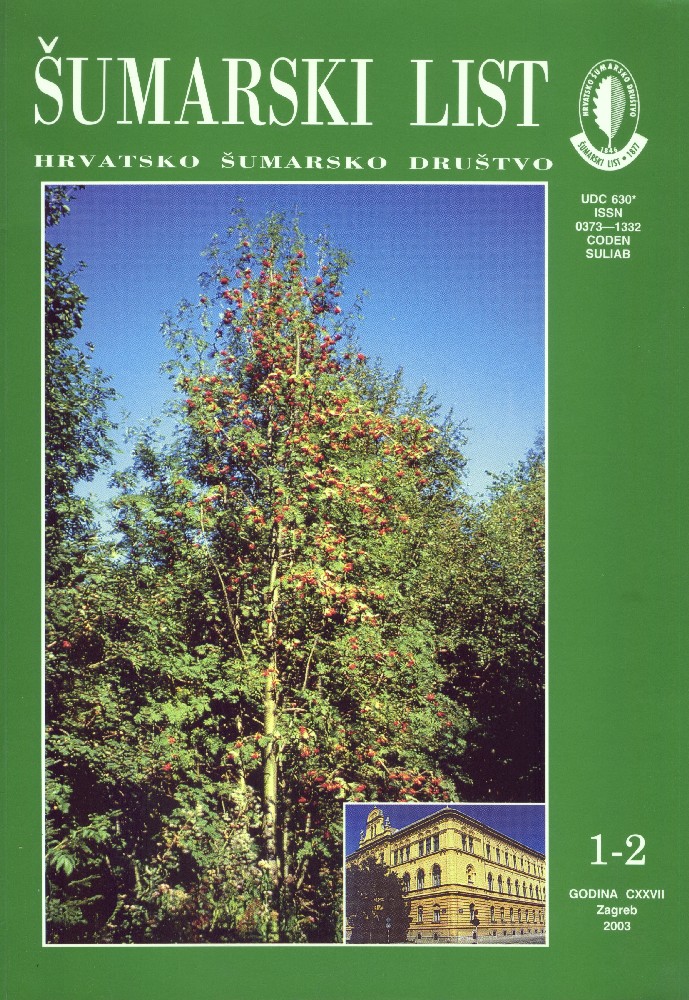
broj: 1-2/2003
pdf (21,5 MB) |
|
||||||||||||||
| IZVORNI ZNANSTVENI ČLANCI | ||
| Trinajstić, I., Franjić, J., Škvorc, Ž. | UDK 630* 188 (001) | |
| Syntaxonomic Analysis of the Beech Forests of Međimurje (Croatia) pdf HR EN | 3 | |
| Zelić, J. | UDK 630* 226 (001) | |
| The Problems of Management with Beech and Silver Fir Selection Forest (Abieti-Fagetum pannonicum Rauš 1969) in the Mountain Papuk pdf HR EN | 11 | |
| PRETHODNO PRIOPĆENJE | ||
| Vodolšak, M., Križaj, D. | UDK 630* 156 | |
| Game Loss and Damages from the Game in the Krapinsko-Zagorska County District pdf HR EN | 27 | |
| Prka, M. | UDK 630* 325 + 851 | |
| Value Characteristics of Common Beech Trees with Regard to the Type of Felling in the Cutting Areas of Bjelovar Bilogora pdf HR EN | 35 | |
| PREGLEDNI ČLANCI | ||
| Franjić, J., Pandža, M., Škvorc, Ž. | UDK 630* 181.1 (Anthyllis barba-jovis L.) | |
| Distribution of Anthyllis barba-jovis L. (Fabaceae) in Croatia pdf HR EN | 45 | |
| Summary: Anthyllis barba-jovis is spread in Croatia in the area presenting the most xerothermal part of the central and southern Dalmatia (cf. Fig. 1). On the Croatian part of the coast, which is almost completely made of carbonate rocks, this species generally grows on the carbonates, although inside its range in the western Mediterranean it is almost completely connected with the silicate rocks. This being a relatively rare species, there are not many data on its distribution in Croatia. As this species has specific requirements in respect to its habitat, namely it cannot stand calcium, its larger distribution in the Croatian littoral cannot be expected at all, and, therefore, every new finding of this species is a real rarity. The research of distribution of this species has not been made so far, and, therefore, this work is the first review of the so-far status of its distribution in Croatia. A. barba-jovis is a western Mediterranean species which in our region has the most eastern boundary of its distribution. Here, it finds a small number of suitable habitats, so most often it occurs individually or in small groups, and very rarely it forms larger populations, such as at Komiža on the island of Vis where it grows on the silicate bed, i.e. on the relict volcanic ash and fragmented lava. By the latest research, one large population of this species has been discovered on the small island of Pelinjak and a somewhat smaller one on the island of Kurba Mala (cf. Fig. 1). As said in the introduction, A. barba-jovis is known also from the island Dugi otok (Grbašćak), that is at the same time its most northern locality on the eastern Adriatic coast (cf. Fig. 1), and the new locality fill in the earlier gaps in the distribution of this species in the central Dalmatia. This being a stenomediterranean species growing on very poor soils unsuitable for a significant development of forest vegetation, any contribution to the knowledge of its distribution, in addition to being a valuable natural science contribution presents also a new knowledge of the vegetation succession on very xenothermal habitats. As this is a woody species from the family Fabaceae (leguminous plants), whose species have the capacity to bind the elementary oxygen from the air, it may be expected that A. barba-jovis will play a pioneer role and will help considerably in the succession toward the forest vegetation. Key words: Anthyllis barba-jovis; distribution; new localities; Croatia | ||
| STRUČNI ČLANCI | ||
| Farkaš-Topolnik, N., Krauthacker, H., Trenc, N. | UDK 630* 907.1 | |
| International Conference "Protected Areas of European Mountains - Place of Life Recreation and Exchange", Chambery, France pdf HR EN | 51 | |


